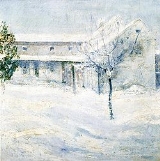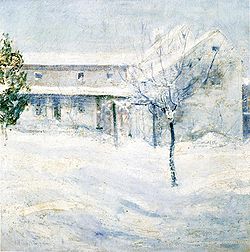
Cos Cob Art Colony
Encyclopedia
The Cos Cob Art Colony was a group of artists, many of them American Impressionists, who gathered in and around Cos Cob
, a section of Greenwich, Connecticut
, from about 1890 to about 1920.
In a joking reference to their predilection for painting views of the vernacular architecture
, group member Childe Hassam
nicknamed the art colony "the Cos Cob Clapboard School of Art."
settled in Greenwich in 1889. The town was only a short train ride from New York City
, yet retained a rural character that appealed to artists. Many of Twachtman's friends came to visit him at his home; among them were Hassam, J. Alden Weir
, Theodore Robinson
, Henry Fitch Taylor
, and Robert Reid
. For longer stays, they boarded at the Holley House (now known as the Bush-Holley House
, a rambling old saltbox overlooking Cos Cob's small harbor.
 During the winter, Twachtman and Weir taught at the Art Students League of New York
During the winter, Twachtman and Weir taught at the Art Students League of New York
. Probably beginning in 1890, Twachtman established summer art classes in Cos Cob; Weir taught with him in 1892 and 1893. Many of the summer students were enrolled at the Art Students League. Among the artists who first visited Cos Cob as summer students were Elmer MacRae, Ernest Lawson
, Allen Tucker
, Charles Ebert, Mary Roberts Ebert, Alice Judson, and Genjiro Yeto.
Other artists associated with the Cos Cob Art Colony include Leonard Ochtman
, Mina Fonda Ochtman
, Dorothy Ochtman, Edward Clark Potter
, Emil Carlsen
, George Wharton Edwards
, and Kerr Eby
. The art colony also included many writers and editors, including Lincoln Steffens
and Willa Cather
.
Members of the Cos Cob Art Colony were deeply involved in organizing the Armory Show
, the exhibition that in 1913 introduced modernist European art to a vast American audience. The art colony formed its own hometown organization in 1911. The Greenwich Society of Artists (now the Greenwich Art Society) held its first exhibition in 1912 at Bruce Museum, which opened to the public for the first time on that occasion.
Cos Cob, Connecticut
Cos Cob is a neighborhood and census-designated place in the town of Greenwich, Connecticut. It is located at 41.033 north, 73.6 west, on the Connecticut shoreline in southern Fairfield County. It had a population of 6,770 at the 2010 census....
, a section of Greenwich, Connecticut
Greenwich, Connecticut
Greenwich is a town in Fairfield County, Connecticut, United States. As of the 2010 census, the town had a total population of 61,171. It is home to many hedge funds and other financial service companies. Greenwich is the southernmost and westernmost municipality in Connecticut and is 38+ minutes ...
, from about 1890 to about 1920.
In a joking reference to their predilection for painting views of the vernacular architecture
Vernacular architecture
Vernacular architecture is a term used to categorize methods of construction which use locally available resources and traditions to address local needs and circumstances. Vernacular architecture tends to evolve over time to reflect the environmental, cultural and historical context in which it...
, group member Childe Hassam
Childe Hassam
Frederick Childe Hassam was a prolific American Impressionist painter, noted for his urban and coastal scenes. Along with Mary Cassatt and John Henry Twachtman, Hassam was instrumental in promulgating Impressionism to American collectors, dealers, and museums...
nicknamed the art colony "the Cos Cob Clapboard School of Art."
History
Artists had been coming to Greenwich to paint since the 1870s, but the art colony began to form when John Henry TwachtmanJohn Henry Twachtman
John Henry Twachtman was an American painter best known for his impressionist landscapes, though his painting style varied widely through his career. Art historians consider Twachtman's style of American Impressionism to be among the more personal and experimental of his generation...
settled in Greenwich in 1889. The town was only a short train ride from New York City
New York City
New York is the most populous city in the United States and the center of the New York Metropolitan Area, one of the most populous metropolitan areas in the world. New York exerts a significant impact upon global commerce, finance, media, art, fashion, research, technology, education, and...
, yet retained a rural character that appealed to artists. Many of Twachtman's friends came to visit him at his home; among them were Hassam, J. Alden Weir
J. Alden Weir
Julian Alden Weir was an American impressionist painter and member of the Cos Cob Art Colony near Greenwich, Connecticut...
, Theodore Robinson
Theodore Robinson
Theodore Robinson was an American painter best known for his impressionist landscapes. He was one of the first American artists to take up impressionism in the late 1880s, visiting Giverny and developing a close friendship with Claude Monet...
, Henry Fitch Taylor
Henry Fitch Taylor
Henry Fitch Taylor was an American artist.-Biography:He was born in Cincinnati in 1853. He studied at the Académie Julian, in Paris. He returned to America in either 1888 or in 1889, and established his studio in New York City. He was part of the Cos Cob Art Colony.He married Clara Sidney Potter...
, and Robert Reid
Robert Reid (painter)
Robert Lewis Reid was an American Impressionist painter and muralist.-Life and work:Robert Reid was born in Stockbridge, Massachusetts and attended the School of the Museum of Fine Arts, Boston under Otto Grundmann, where he was also later an instructor...
. For longer stays, they boarded at the Holley House (now known as the Bush-Holley House
Bush-Holley House
The Bush-Holley House is a National Historic Landmark in the Cos Cob section of Greenwich, Connecticut. It was constructed circa 1730 and in the late nineteenth century was a boarding house and the center of the Cos Cob Art Colony...
, a rambling old saltbox overlooking Cos Cob's small harbor.

Art Students League of New York
The Art Students League of New York is an art school located on West 57th Street in New York City. The League has historically been known for its broad appeal to both amateurs and professional artists, and has maintained for over 130 years a tradition of offering reasonably priced classes on a...
. Probably beginning in 1890, Twachtman established summer art classes in Cos Cob; Weir taught with him in 1892 and 1893. Many of the summer students were enrolled at the Art Students League. Among the artists who first visited Cos Cob as summer students were Elmer MacRae, Ernest Lawson
Ernest Lawson
Ernest Lawson was a Canadian-American painter and a member of The Eight, a group of artists which included the group's leaders Robert Henri, Everett Shinn, John Sloan, Arthur B. Davies, Maurice Prendergast, George Luks, and William J. Glackens...
, Allen Tucker
Allen Tucker
Allen Tucker was an American artist.-Biography:He was born in Brooklyn, New York in 1866 and graduated from the School of Mines of Columbia University in 1887 with a degree in architecture and worked as a draftsman at McIlvaine and Tucker. He died in 1939.-References:...
, Charles Ebert, Mary Roberts Ebert, Alice Judson, and Genjiro Yeto.
Other artists associated with the Cos Cob Art Colony include Leonard Ochtman
Leonard Ochtman
Leonard Ochtman was an American Impressionist painter who specialized in landscapes. He was born in Zonnemaire, Netherlands as the son of a decorative painter. His family moved to Albany, New York in 1866. Starting at a young age, Ochtman worked as a draftsman at a wood-working firm in Albany...
, Mina Fonda Ochtman
Mina Fonda Ochtman
Mina Fonda Ochtman was the wife of the American painter Leonard Ochtman and a notable American Impressionist in her own right. She was a part of the Cos Cob Art Colony and lived in Greenwich, Connecticut. Their daughter, Dorothy Ochtman Del Mar, was also a painter of note.-References:*...
, Dorothy Ochtman, Edward Clark Potter
Edward Clark Potter
Edward Clark Potter was an American sculptor best known for his equestrian and animal statues. His works include the "Fortitude" lion in front of the New York Public Library.-Early years:...
, Emil Carlsen
Emil Carlsen
Soren Emil Carlsen was an American Impressionist painter who emigrated to the United States from Denmark...
, George Wharton Edwards
George Wharton Edwards
George Wharton Edwards was an American impressionist painter and illustrator and author of several books of travel and historical subjects. His books which included his own illustrations included such titles as Holland, London, and Vanished Halls and Cathedrals of France.Edwards was educated at...
, and Kerr Eby
Kerr Eby
Kerr Eby was an Canadian illustrator best known for his renderings of soldiers in combat in the First and Second World Wars. He is held in a similar regard to Harvey Dunn and the other famous illustrators dispatched by the government to cover the First World War.Born in Tokyo, Japan to Canadian...
. The art colony also included many writers and editors, including Lincoln Steffens
Lincoln Steffens
-Biography:Steffens was born April 6, 1866, in San Francisco. He grew up in a wealthy family and attended a military academy. He studied in France and Germany after graduating from the University of California....
and Willa Cather
Willa Cather
Willa Seibert Cather was an American author who achieved recognition for her novels of frontier life on the Great Plains, in works such as O Pioneers!, My Ántonia, and The Song of the Lark. In 1923 she was awarded the Pulitzer Prize for One of Ours , a novel set during World War I...
.
Members of the Cos Cob Art Colony were deeply involved in organizing the Armory Show
Armory Show
Many exhibitions have been held in the vast spaces of U.S. National Guard armories, but the Armory Show refers to the 1913 International Exhibition of Modern Art that was organized by the Association of American Painters and Sculptors...
, the exhibition that in 1913 introduced modernist European art to a vast American audience. The art colony formed its own hometown organization in 1911. The Greenwich Society of Artists (now the Greenwich Art Society) held its first exhibition in 1912 at Bruce Museum, which opened to the public for the first time on that occasion.

